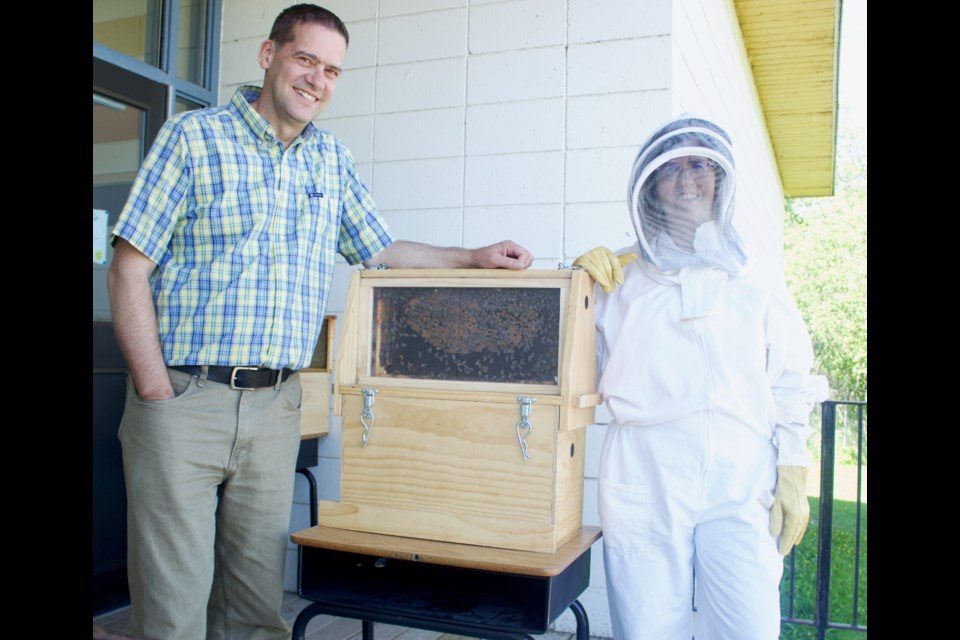The Christy Creek Honey farm in Lac La Biche County is hoping to house more than a million bees this season, but honey farm owner Rob Wicker says the bee industry has been stung over the last two years by a steady decline in bee populations due to parasites and weather conditions.
It’s the worst he’s seen since starting the business in 2016.
“It's been a difficult two years. I used to have 10 to 20 per cent losses, but in the last couple years, roughly 60 to 70 per cent of my hives died. It’s been a little discouraging.”
Wicker’s losses are in line with the worldwide reduction in bee populations in apiaries and also in the wild.
The decline within the 14 hives at the Christy Creek farm is primarily due to a parasitic arachnids species—Varroa Mites. The parasites come from Asia and are incredibly destructive to honeybees—especially in the winter.
“They really weaken the hives, so when the Varroa Mite spread is bad, the hives are much more likely to die over the winter, “ he said, especially during a vulnerable winter season when bees are trying to stay warm and alive. Making things worse, the parasite has also built immunity to pesticides and has infected most of North America.
Survival
Christy Creek has two species of honeybee they farm—the European Honeybee and local bumblebee. While the European variety has survived much of the parasitic blight, the local bees have been hit hard, Wicker said.
Adding to the challenges, another virus has also taken aim at bees, affecting all species called the ‘deformed wing virus’—it targets the physical development of bees.
“There is a new one coming down the pipe called deformed wing virus. If they don’t figure out how to treat it, it’s also going to be very hard on the honeybee population,” said Wicker expressing concern for bees that aren’t part of bee farms, with no access to monitoring or care. “Native bees don’t have people that are treating them or working to keep them healthy because they're in the wild. So unfortunately the Varroa Mites and other illnesses that are spreading to our bumblebees and other pollinators are really having a negative impact on them.”
Human reaction to bees also continues to be a factor in lifecycles and populations, he adds. Many people may simply destroy a bees nest if they locate one at their home or in their yard. Wicker realizes that bees can be a concern, but urges residents to call an expert who can safely remove and relocate the hive and the swarm.
“If you have a bumblebee nest around your property you should either leave it alone or call someone like me who can come and hopefully remove it and transplant it to another place,” he said, which also helps farms like Christy Creek replenish their bee population.
“Hopefully someone will phone me and say ‘hey I’ve got a bumblebee nest in my wall’ and I will come and capture it and bring it home,'' he smiled.
The summer season is a busy one for the farm ... and its bees. After a winter that sees the bees housed in their bee hives making enough heat to stay comfortably warm, they are now busy creating honeycombs of nectar collected from blossoming flowers. Wicker says that despite the population drops and continuing challenges for the industry, the Alberta bee and honey industry is adapting and thriving.
Even with the challenges, Wicker says Alberta is still one of the best places for bee populations that are vital to the agricultural industry to thrive. Ultimately, it's a matter of staying up to date and monitoring the pollinating species, he said.
“I think the future for honey production is good in Alberta, I think there are some challenges with disease that are coming along and people need to stay up to date on the best practices of beekeeping in terms of diseases and how to take care of them.”
Hive tours
Wicker and his family encourage residents to learn more about the bee and honey industry. They offer guided tours and demonstrations of their farm process during the summer months.
With what could be up to 80,000 bees in each of the farm’s 14 hives, Wicker is still hopeful he will be able to utilize up to a million bees this year for honey production, and offer an informative glimpse into the bee world for visitors.
“Well show you the different kinds of bees; the workers, the drones, the queens, the eggs, the larvae, honey, pollen and everything that’s in a hive,” adding with a grin that the farm does provide full beekeeper suits and netted helmets to let visitors get close to the action.



